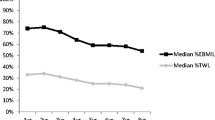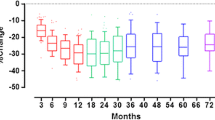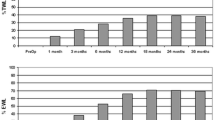Abstract
Background
Bariatric surgery is currently the most effective treatment for morbid obesity. It provides not only substantial weight loss, but also resolution of obesity-related comorbidities. Laparoscopic sleeve gastrectomy (LSG) has rapidly been gaining in popularity. However, there are limited data on the reduction of obesity-related comorbidities for LSG compared to laparoscopic Roux-en-Y gastric bypass (LRYGB). The aim of this study was to assess the effectiveness of laparoscopic LSG versus LRYGB for the treatment of obesity-related comorbidities.
Methods
A total of 558 patients who underwent either LSG or LRYGB for morbid obesity at the Westchester Medical Center between April 2008 and September 2010 were included. Data were collected prospectively into a computerized database and reviewed for this study. Fisher’s exact test analyses compared 30-day, 6-month, and 1-year outcomes of obesity-related comorbidities.
Results
A total of 558 patients were included in the analysis of obesity-related comorbidity resolution; 200 underwent LSG and 358 underwent LRYGB. After 1 year, 86.2 % of the LSG patients had one or more comorbidities in remission compared to 83.1 % LRYGB patients (P = 0.688). With the exception of GERD (−0.09 vs. 50 %; P < 0.001), similar comorbidity remission rates were observed between LSG and LRYGB for sleep apnea (91.2 vs. 82.8 %; P = 0.338), hyperlipidemia (63 vs. 55.8 %; P = 0.633), hypertension (38.8 vs. 52.9 %; P = 0.062), diabetes (58.6 vs. 65.5 %; P = 0.638), and musculoskeletal disease (66.7 vs. 79.4 %; P = 0.472).
Conclusions
Laparoscopic sleeve gastrectomy markedly improves most obesity-related comorbidities. Compared to LRYGB, LSG may have equal in reducing sleep apnea, hyperlipidemia, hypertension, diabetes, and musculoskeletal disease. LRYGB appears to be more effective at GERD resolution than LSG.







Similar content being viewed by others
References
Wang Y, Beydoun MA, Liang L, Caballero B, Kumanyika SK (2008) Will all Americans become overweight or obese? Estimating the progression and cost of the US obesity epidemic. Obesity 16:2323–2330
Buchwald H, Avidor Y, Braunwald E, Jensen MD, Pories W, Fahrbach K, Schoelles K (2004) Bariatric surgery: a systematic review and meta-analysis. JAMA 292:1724–1737
Hess DS, Hess DW (1998) Biliopancreatic diversion with a duodenal switch. Obes Surg 8:267–282
Cottam D, Qureshi FD, Mattar SG, Sharma S, Holover S, Bonanomi G, Ramanathan R, Schauer P (2006) Laparoscopic sleeve gastrectomy as an initial weight-loss procedure for high risk patients with morbid obesity. Surg Endosc 20:859–863
Regan JP, Inabnet WB, Gagner M, Pomp A (2003) Early experience with two-stage laparoscopic Roux-en-Y gastric bypass as an alternative in the super–super obese patient. Obes Surg 13:861–864
Ren CJ, Patterson E, Gagner M (2000) Early results of laparoscopic biliopancreatic diversion with duodenal switch: a case series of 40 consecutive patients. Obes Surg 10:514–523
Brethauer SA, Hammel JP, Schauer PR (2009) Systematic review of sleeve gastrectomy as staging and primary bariatric procedure. Surg Obes Relat Dis 5:469–475
Nguyen NT, Root J, Zainabadi K, Sabio A, Chalifoux S, Stevens CM, Mavandadi S, Longoria M, Wilson SE (2005) Accelerated growth of bariatric surgery with the introduction of minimally invasive surgery. Arch Surg 140:1198–1202
Boza C, Salinas J, Salgado N, Pérez G, Raddatz A, Funke R, Pimentel F, Ibáñez L (2012) Laparoscopic sleeve gastrectomy as a stand-alone procedure for morbid obesity: report of 1,000 cases and 3-year follow-up. Obes Surg 22(6):866–871
Kehagias I, Karamanakos SN, Argentou M, Kalfarentzos F (2011) Randomized clinical trial of laparoscopic Roux-en-Y gastric bypass versus laparoscopic sleeve gastrectomy for the management of patients with BMI < 50 kg/m2. Obes Surg 21:1650–1656
Rossi M, Serpa Neto A, Rossi FM, Amarante RD, Alcântara GC Jr, da Silva RB, Regina PF (2009) Percentage of excess BMI lost correlates better with improvement of metabolic syndrome after Roux-en-Y gastric bypass in morbidly obese subjects: anthropometric indexes and gastric bypass. Surg Obes Relat Dis 5:11–18
Suter M, Donadini A, Romy S, Demartines N, Giusti V (2011) Laparoscopic Roux-en-Y gastric bypass: significant long-term weight loss, improvement of obesity-related comorbidities and quality of life. Ann Surg 254:267–273
Keren D, Matter I, Rainis T, Lavy A (2011) Getting the most from the sleeve: the importance of post-operative follow-up. Obes Surg 21:1887–1893
Chopra A, Chao E, Etkin Y, Merklinger L, Lieb J, Delany H (2012) Laparoscopic sleeve gastrectomy for obesity: can it be considered a definitive procedure? Surg Endosc 26:831–837
Srinivasa S, Hill LS, Sammour T, Hill AG, Babor R, Rahman H (2010) Early and mid-term outcomes of single-stage laparoscopic sleeve gastrectomy. Obes Surg 20(11):1484–1490
D’Hondt M, Vanneste S, Pottel H, Devriendt D, Van Rooy F, Vansteenkiste F (2011) Laparoscopic sleeve gastrectomy as a single-stage procedure for the treatment of morbid obesity and the resulting quality of life, resolution of comorbidities, food tolerance, and 6-year weight loss. Surg Endosc 25:2498–2504
Arias E, Martinez PR, Ka Ming Li V, Szomstein S, Rosenthal R (2009) Mid-term follow-up after sleeve gastrectomy as a final approach for morbid obesity. Obes Surg 19:544–548
Hutter MM, Schirmer BD, Jones DB, Ko CY, Cohen ME, Merkow RP, Nguyen NT (2011) First report from the American College of Surgeons Bariatric Surgery Center Network: laparoscopic sleeve gastrectomy has morbidity and effectiveness positioned between the band and the bypass. Ann Surg 254:410–420
Rosenthal RJ, Diaz AA, Arvidsson D, Baker RS, Basso N, Bellanger D (2012) International Sleeve Gastrectomy Expert Panel Consensus Statement: best practice guidelines based on experience of >12,000 cases. Surg Obes Relat Dis 8:8–19
Akinnusi ME, Saliba R, Porhomayon J, El-Solh AA (2012) Sleep disorders in morbid obesity. Eur J Intern Med 23:219–226
Young T, Peppard PE, Taheri S (2005) Excess weight and sleep-disordered breathing. J Appl Physiol 99:1592–1599
Schafer H, Pauleit D, Sudhop T, Gouni-Berthold I, Ewig S, Berthold HK (2002) Body fat distribution, serum leptin, and cardiovascular risk factors in men with obstructive sleep apnea. Chest 122:829–839
Sutherland K, Lee RW, Phillips CL, Dungan G, Yee BJ, Magnussen JS, Grunstein RR, Cistulli PA (2011) Effect of weight loss on upper airway size and facial fat in men with obstructive sleep apnoea. Thorax 66:797–803
Shuldiner AR, Yang R, Gong DW (2011) Resistin, obesity and insulin resistance—the emerging role of the adipocyte as an endocrine organ. N Engl J Med 345:1345–1346
Ramón JM, Salvans S, Crous X, Puig S, Goday A, Benaiges D, Trillo L, Pera M, Grande L (2012) Effect of Roux-en-Y gastric bypass vs sleeve gastrectomy on glucose and gut hormones: a prospective randomised trial. J Gastrointest Surg 16(6):1116–1122
Lakdawala MA, Bhasker A, Mulchandani D, Goel S, Jain S (2010) Comparison between the results of laparoscopic sleeve gastrectomy and laparoscopic Roux-en-Y gastric bypass in the Indian population: a retrospective 1 year study. Obes Surg 20:1–6
Yehoshua R, Eidelman L, Stein M, Fichman S, Mazor A, Chen J, Bernstine H, Singer P, Dickman R, Beglaibter N, Shikora SA, Rosenthal RJ, Rubin M (2008) Laparoscopic sleeve gastrectomy–volume and pressure assessment. Obes Surg 18:1083–1088
Keidar A, Appelbaum L, Schweiger C, Elazary R, Baltasar A (2010) Dilated upper sleeve can be associated with severe postoperative gastroesophageal dysmotility and reflux. Obes Surg 20:140–147
Braghetto I, Lanzarini E, Korn O, Valladares H, Molina JC, Henriquez A (2010) Manometric changes of the lower esophageal sphincter after sleeve gastrectomy in obese patients. Obes Surg 20(3):357–362
Klaus A, Weiss H (2008) Is preoperative manometry in restrictive bariatric procedures necessary? Obes Surg 18:1039–1042
Himpens J, Dapri G, Cadiere GB (2006) A prospective randomized study between laparoscopic gastric banding and laparoscopic isolated sleeve gastrectomy: results after 1 and 3 years. Obes Surg 16:1450–1456
Ochner CN, Gibson C, Shanik M, Goel V, Geliebter A (2011) Changes in neurohormonal gut peptides following bariatric surgery. Int J Obes (Lond) 35:153–166
Scott WR, Batterham RL (2011) Roux-en-Y gastric bypass and laparoscopic sleeve gastrectomy: understanding weight loss and improvements in type 2 diabetes after bariatric surgery. Am J Physiol Regul Integr Comp Physiol 301:R15–R27
Sarkhosh K, Birch DW, Shi X, Gill RS, Karmali S (2012) The impact of sleeve gastrectomy on hypertension: a systematic review. Obes Surg 22:832–837
Kotchen TA (2010) Obesity-related hypertension: epidemiology, pathophysiology, and clinical management. Am J Hypertens 23:1170–1178
Acknowledgments
We thank Nancy Nolan, RN, who worked on the data collection system and provided the detailed data for statistical analysis.
Disclosures
Niu Zhang, Anthony Maffei, Thomas Cerabona, Juan Omana, Anil Pahuja and Ashutosh Kaul have no conflicts of interest or financial ties to disclose.
Author information
Authors and Affiliations
Corresponding author
Rights and permissions
About this article
Cite this article
Zhang, N., Maffei, A., Cerabona, T. et al. Reduction in obesity-related comorbidities: is gastric bypass better than sleeve gastrectomy?. Surg Endosc 27, 1273–1280 (2013). https://doi.org/10.1007/s00464-012-2595-7
Received:
Accepted:
Published:
Issue Date:
DOI: https://doi.org/10.1007/s00464-012-2595-7




